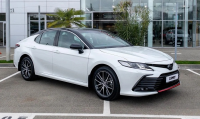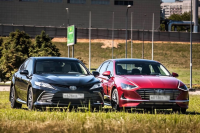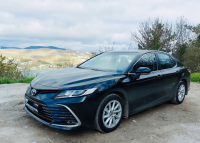The current generation Toyota Camry appeared in Ukraine three years ago; since then, the car has become very popular. And here's the update: a powerful new engine, an 8-speed automatic, and a number of interior changes. Will all that help Toyota Camry maintain its popularity and leadership position in the class? Let us tell and discuss.
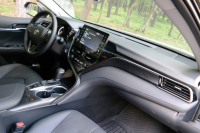
Table of contents
An updated version of the Toyota Camry? What's been updated?
At a cursory glance, the updated car can be recognized most easily by a new front bumper and integrated grille. If earlier the noticeable radiator grill stretched in all width, now its central part (exactly where the radiator is) and angular sections, which have received chromeplated brackets on bumper's corners, are distinctly allocated. In addition, the decorative "tendrils" under the logo are designed differently. And also there are new two-tone 18-inch wheels. That's actually all...
In fact, the body has not changed globally. We face a low and wide, almost "sprawling" on the road 3-volume sedan: zones of a bonnet, passenger compartment and a separate luggage rack are allocated accurately. Narrow headlamps with lower risers make the design recognisable from the front. And the huge nameplate in the centre of the boot lid and the voluminous lights serve a similar purpose when viewed from the rear. The feeling is that in the '70s, the Toyota Camry has finally got over its self-consciousness, daring to be at least somewhat conspicuous and recognisable in traffic.
Only details have changed: completely new front bumper and other wheel disks. But as a whole, the design is familiar - we shall say, "soft JDM-style" that I liked personally during the first acquaintance with the automobile.
The same minimal changes have been made in the interior - in fact, only the front panel has been visibly redesigned. It's a pity, but exactly these changes can hardly be called successful. Dark planks with hardly appreciable decor are installed instead of obscure, but at least original "copper wood". As a result, all this merges into single grey-black array at the front. In addition, the ventilation deflectors have been lowered, and the touchscreen display has been enlarged (it's now a maximum of 9 inches) and raised up, making it a separate element. And it shows: previously the central part of the front panel was organic in its wavy lines, the display was integrated into its allotted place, buttons-switches were neatly arranged around it. Now that organism is broken. The freestanding display suits the "chopped-and-straight" interior of the RAV4, but hardly suits the Camry with its soft curves.
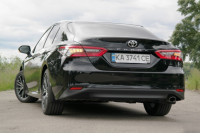
But the interior isn't just about the front fascia, is it? Otherwise, the interior of novelty Toyota Camry 2021 is good: very spacious in front and behind, there is a sense of "air" over head (to the envy of other "Japanese"), there is enough place for knees. Front seats are voluminous and soft, as if your favourite home seat. Fears concerning "summer sweating" from simple leather trimming are dissipated in a moment by powerful built-in ventilation. The back part is absolutely exemplary for this segment: sofa with separate adjustment of backs' inclination, deflectors ventilation and seats' heating, separate zone "climate", an opportunity to control audio system and a sun shade - all this again raises Toyota Camry 2021 to the top of a class of "national business sedans"! Yes, there are better ones out there. You can take the related sedan Lexus ES as an example: bigger wheelbase, possibility of sliding of the front passenger seat, better leather trimming. Once again: yes, there is better. Only this "better" costs absolutely other money.
The two main changes in the interior are the enlarged display on a separate pedestal and new dark decorative trim. It seems to me that the interior has lost its 'lightness' in design and zest in finish. The only way out is to opt for light trim: everything looks nicer that way. But what the interior has not lost is the excellent space and excellent comfort. Front seats remind cosy domestic armchairs, in expensive complete sets ventilation and electric drive of settings with memory (two memory positions for a driver's seat) are provided. In back, we are still glad about spaciousness and a miracle armrest with numerous functions: control of "climate" and angle of recline, heating of seats and motorized curtain, etc. Plus, ventilation deflectors, USB-ports for charging gadgets, side curtains. The boot hasn't changed: sufficient volume and full-fledged "spare", but simple trim and only a couple of hooks for packages. A hatch for skis or long luggage has been added.
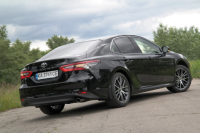
Only the exterior and interior? Not so much...
Not only. The main change is inside - the new engine and a new automatic. Under a bonnet of the mass versions of Toyota Camry there is still 2.5-litre four-cylinder petrol engine. But if in the past this was 2AR-FE engine (181 hp), now it is A25A-FKS (207 hp) from Dynamic Force series.
The engine is characterised by D-4S dual injection and multipoint nozzles for even fuel atomisation, variable valve timing (inlet/outlet), a variable capacity oil pump, high compression ratio (13:1) and the ability to operate on the Atkinson/Miller cycle. All of these features result in a very high efficiency of around 40%, reflecting the motor's efficiency: less fuel consumption for more output. Paired with the new engine is now a Direct Shift 8AT instead of a 6-speed gearbox: a more compact 6-speed automatic with a wider gear ratio and reduced losses.
To close the issue with technical changes, I'd like to mention that TSS (Toyota Safety Sense) functionality has been extended for updated version of Toyota Camry 2021. Thus, not only lane keeping function is added but also Lane Keeping Assist (LTA). In addition, the Toyota Camry 2021 sedan is now able to monitor oncoming cars at the intersection, pr. Finally, wireless charging and blind spot monitoring of rear-view mirrors are available for petrol-electric versions of Toyota Camry. This equipment wasn't available when the model was launched, then it appeared, but only on the hybrid. And now I meet these useful 'little things' on the updated car.
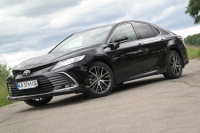
The main changes are the engine and the automatic. Depending on the country of sales, the engine of Dynamic Force series and 8-speed automatic transmission have already been met in arsenal of Toyota Camry of current generation. But this technique is new for Ukrainian variants of Toyota Camry. The architecture of TNGA and the platform GA-K are already familiar: independent suspensions of all wheels, transverse installation of the engine, front drive (for the majority of countries, Ukraine is among them).
Oh-o-o, it is more interesting! How does it go with a new motor and "automatic device"?
If not to concentrate on increased capacity of the motor and new automatic transmission, it is difficult to catch the difference in habitual everyday driving: it simply accelerates, simply drives. A usual start from a traffic light or smooth acceleration while running occur in the range of 2-3 thousand rpm, the car simply follows the accelerator pedal, "automatic machine" gently switches up gears. By the way, there are so many gears, and their shifts are so smoothed, that one feels like driving a variator sometimes. And here is another observation: even at speeds of 60-70 km/h the "automat" aspires to get higher gears. In view of what the engine works at 1,2-1,3-1,5 thousand rpm: a minimum of rpm, a minimum of fuel, a minimum of noise. In fact, the engine is frankly "top drive", the maximum capacity and the torque is reached at high revolutions. The automatic device knows it perfectly. It is necessary to press the accelerator pedal stronger - as it turns out that the engine's capacity is really great! On high revolutions (4-6 thousand) it fulfils each, from declared "200 + horses": fast acceleration and good catch-up, readiness "twists" up to 6-6,5 thousand revolutions, preserving traction and dynamics. On a motorway this engine allows overtaking with good reserve and confidence. In a city the 8-step automatic transmission which is able to dump transmissions quickly, "driving" the motor into zones of high revolutions when it is necessary to accelerate sharply helps.
True, there are two remarks. First, the engine makes noise appreciably at high revolutions (4 thousand and above). Moreover, it is not beautiful sound - roar, but simply noise - humming. Therefore, if to drive "at a sound", you get either smoothly-unhurriedly-economically, or "at all money", but putting up with noise. Secondly, the "watershed" of pressing the accelerator pedal, at which the automatic transmission shifts down, is not easy to find. There were cases when it was necessary to accelerate at a little bit faster than usual and one had to press the pedal more actively. But the engine and the box have already perceived it as a command "fass!": to drop two gears, higher revolutions, engine roar, high speed acceleration... But why? It was quite possible to "pull" at the expense of traction within the limits of one gear. It is a pity that switching of driving modes is not provided for this automobile - there is only S-mode of "automata". In a word, one should get used to the character of behavior of the new engine and 8 steps "automatic device". But as a whole, the range of their opportunities - on dynamics, acceleration, efficiency - is appreciably expanded in comparison with the past.
As for the running gear, the Camry is all its own: plenty of comfort in all conditions! If you drive fast on a road with numerous patches, the car will only wobble gently. Thus the amplitude of swings is insignificant, even the person with a weak vestibular apparatus will not get sick here. If you pass a separate hole or protruding/deflected hatch cover, the automobile will disturb the passengers only with hardly appreciable vertical disturbance. Moreover, as if through a thick layer of rubber, it is rounded and lubricated as much as possible. In fact, I write all this for 18 wheels with 45th profile of tyres! At the same time, the present generation of Toyota Camry is quite normal steering. Yes, there is no "dialogue in a steering wheel" that Mazda6 or Peugeot 508 provide, there is no "academic standard" named Volkswagen Passat. But there is a sensation of confidence. All due to that the steering wheel is a little bit heavy (for such chassis and such adjustment of suspension, I would expect lighter steering wheel). But with its deviations and turns one has no feeling that all this is for nothing: the car turns normally, almost without lags and with rather small rolls. It is only sound insulation that prevents to call behavior and driving of Toyota Camry maximally comfortable: the engine is periodically heard, at speeds over 100-120 km/h already noticeably cut through aerodynamic noises.
Under the bonnet is still a 2.5-litre four-cylinder atmospheric petrol engine. But it is absolutely another generation of the engine, with which another "automatic" (now 8-speed) works. Therefore, both dynamics and consumption have changed. My 0-100km/h measurement gives a 'departure' of 9 seconds (claimed 8.7 seconds, in the past it was 9.7 seconds). Average city fuel consumption was 9-9.5 litres per 100km journey. Of course, given the large number of traffic jams, you can get the consumption of about 11 litres per 100 kilometers in the city, but also with empty roads and smoothly driving style can reach a mark of 7-7.5 liters per "hundredth". On the highway at speeds of 80-90 km / h fuel consumption is 4.5-5 per 100 kilometers, at speeds of 110-120 km / h - about 5.5-6 liters per 100 kilometers. As a result: with improved dynamics in passing in all driving modes we receive significant fuel economy. Someone will say "it is difficult to put HFO on a new engine," and I will answer "because the fuel consumption is already appreciably decreased. If you want more economy in long-term operation and are ready to pay for it at once, look at a hybrid.
Yes, by the way - what about the hybrid version? Has it changed? And the other options? Is there a V6?
The easiest way to answer the question about the V6 version: it is not in the general price list of Toyota Camry now. Only petrol cars with a new 2,5-liter motor or hybrids on the basis of a similar engine (code A25A-FXS) are offered for Ukraine. Separate material was previously published about sedan Toyota Camry Hybrid, since then its techniques and characteristics have not changed: total power of 218 hp, claimed acceleration from 0-100 km/h in 8.3 seconds, consumption of 4.4-5.2 liter per 100 km of way. Does it mean that changes of the hybrid version are reduced only to appearance and interior? Not absolutely: the hybrid is also differed by extended options.
Thus, Toyota Camry in average completing Elegance (from UAH 859 thnd or $31,5 thnd) may offer LED-lights, leather trimming of the interior, seats with electric drive, central touch screen, 2-zoned "climate", etc. As alternative, sedan Toyota Camry Hybrid is available in completing Elegance+ (from UAH 952 thnd or about $35 thnd): hybrid power-unit plus air ionizer and start the engine with a button.
The next step is Toyota Camry with Prestige kitting (from UAH 920,000 or about $33,700): additional 9-inch touch screen display, wireless smartphone charging, sensor sensors in front and rear bumpers, etc. And Toyota Camry Hybrid version Prestige+ (from UAH 1,02 mn or a bit over $37,000) still offers 18-inch wheels, changed headlights (with three risks), "blind spots" control, etc.
At the top of the lineup is Toyota Camry Premium (from 1,06 million UAH or $38,5 thou): a rear sofa with adjustable angle of backrest, multifunctional armrest, 3-zoned "climate", heating of rear seats, ventilation of front seats, JBL audio system, etc. The car Toyota Camry Hybrid in "Premium+" configuration (from 1,13 million UAH or $41,5 thou) additionally differs the following: projection of data on a windshield, all-round view PVM on four cameras on perimeter of the car, etc.
At last, only usual petrol version of Toyota Camry is available in starting configuration Comfort (from UAH 791 thnd or $29 thnd): exactly the point where the model Camry begins in general. And vice versa: only for regular petrol version of Toyota Camry, the Premium variant with a panoramic roof is available. There are no such options for the Toyota Camry Hybrid at the moment.
Under the bonnet, there's still a 2.5-litre four-cylinder atmospheric petrol engine. But it's a completely different generation of engine, with a different automatic (now 8-speed). Therefore, both dynamics and consumption have changed. My 0-100km/h measurement gives a 'departure' of 9 seconds (claimed 8.7 seconds, in the past it was 9.7 seconds). Average city fuel consumption was 9-9.5 litres per 100km journey. Of course, given the large number of traffic jams, you can get the consumption of about 11 litres per 100 kilometers in the city, but also with empty roads and smoothly driving style can reach a mark of 7-7.5 liters per "hundredth". On the highway at speeds of 80-90 km / h fuel consumption is 4.5-5 per 100 kilometers, at speeds of 110-120 km / h - about 5.5-6 liters per 100 kilometers. As a result: with improved dynamics in passing in all driving modes we receive significant fuel economy. Someone will say "it is difficult to put HFO on a new engine," and I will answer "because the fuel consumption is already appreciably decreased. If you want more economy in long-term operation and are ready to pay for it at once, look at a hybrid.
Yes, by the way - what about the hybrid version? Has it changed? And the other options? Is there a V6?
The easiest way to answer the question about the V6 version: it is not in the general price list of Toyota Camry now. Only petrol cars with a new 2,5-liter motor or hybrids on the basis of a similar engine (code A25A-FXS) are offered for Ukraine. Separate material was previously published about sedan Toyota Camry Hybrid, since then its techniques and characteristics have not changed: total power of 218 hp, claimed acceleration from 0-100 km/h in 8.3 seconds, consumption of 4.4-5.2 liter per 100 km of way. Does it mean that changes of the hybrid version are reduced only to appearance and interior? Not absolutely: the hybrid is also differed by extended options.
Thus, Toyota Camry in average completing Elegance (from UAH 859 thnd or $31,5 thnd) may offer LED-lights, leather trimming of the interior, seats with electric drive, central touch screen, 2-zoned "climate", etc. As alternative, sedan Toyota Camry Hybrid is available in completing Elegance+ (from UAH 952 thnd or about $35 thnd): hybrid power-unit plus air ionizer and start the engine with a button.
The next step is Toyota Camry with Prestige kitting (from UAH 920,000 or about $33,700): additional 9-inch touch screen display, wireless smartphone charging, sensor sensors in front and rear bumpers, etc. And Toyota Camry Hybrid version Prestige+ (from UAH 1,02 mn or a bit over $37,000) still offers 18-inch wheels, changed headlights (with three risks), "blind spots" control, etc.
At the top of the lineup is Toyota Camry Premium (from 1,06 million UAH or $38,5 thou): a rear sofa with adjustable angle of backrest, multifunctional armrest, 3-zoned "climate", heating of rear seats, ventilation of front seats, JBL audio system, etc. The car Toyota Camry Hybrid in "Premium+" configuration (from 1,13 million UAH or $41,5 thou) additionally differs the following: projection of data on a windshield, all-round view PVM on four cameras on perimeter of the car, etc.
At last, only usual petrol version of Toyota Camry is available in starting configuration Comfort (from UAH 791 thnd or $29 thnd): exactly the point where the model Camry begins in general. And vice versa: only for regular petrol version of Toyota Camry, the Premium variant with a panoramic roof is available. There are no such options for the Toyota Camry Hybrid at the moment.
The exemplary cars are shown in the photos. The black car is presented in the starting kit Comfort: new engine and 8-speed automatic. "automatic", 17 wheels with thicker tyres (even more softness!), fabric seat upholstery, simpler instruments and smaller central display. But even here there's Apple CarPlay and Android Auto support, plus LED headlights and heated steering wheel. The white car is the hybrid version in the Prestige+ package (and looks like Premium). And in general, the hybrid offers not only differences in terms of technology, but also in terms of equipment: for example, the maximum versions of Toyota Camry Hybrid have PVM all-round visibility and projection on the windshield. Besides, only the hybrid has buttons for choice of driving modes: Eco/Normal/Sport. If to speak about petrol versions, their price practically has not changed concerning the first review: depending on a complete set, the car "fits" in $29-39 thousand - a buyer gets a new motor and "automatic device" "for a thank you"! Hybrids are more expensive approximately by $3-3,5 thousand: it is a payment for machinery under a cowl, and for the expanded equipment.
The result: to buy or not?
The planned updating usually cannot cardinally change character of the automobile, but can present a pair of pleasant "pluses". Exactly so happened this time. In this case, the pluses are the new 2,5-liter engine and the 8-in steps "automatic device", which have appreciably affected both dynamics of the automobile, and its efficiency.
On the whole, the Toyota Camry 2021 remains the same: an emphasis on suspension comfort, good interior space, quite an adequate price tag, and excellent liquidity. Exactly these qualities have provided Toyota Camry with popularity for many years, even decades. And, judging by sales, they still remain actual today for many Ukrainian buyers. And made updates will help this successful car to keep its positions among leaders of class at least for the next couple of years.
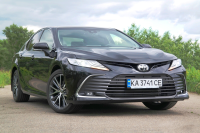
,-but-more-substandard-2.png)
